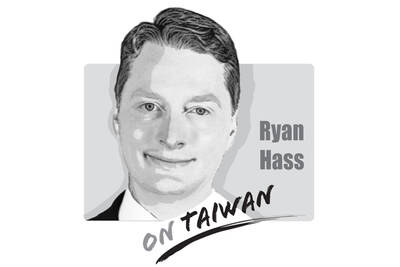The English translation of Yuan Xiao Festival (元宵節) as “lantern festival” — celebrated on the 15th day of the first lunar month — has been used in English-speaking countries for ages.
The celebration of dengjie (燈節), which literally means “lantern festival,” has been around since antiquity in China. The Chinese name popularly used today, denglong jie (燈籠節), is a more recent arrival.
On the day of the festival, people decorate buildings with lanterns or carry them around. Consequently, the English translation “lantern festival” could well be a direct translation from the Chinese.
The Oxford English Dictionary has added the term “lantern festival” and provides an example of published text about the festival in Taipei. It cites former president Chen Shui-bian (陳水扁): “[He] talked about the importance of culture and the cultural institutions he established as Taipei mayor, such as the Hakka Cultural Foundation, the Taipei Film Festival and the Lantern Festival.”
For the Taipei Lantern Festival to make its way into the eminent dictionary is indeed noteworthy.
However, the Taipei festival was not alone in receiving international recognition. For the past few decades, the Pingsi Sky Lantern Festival has risen to international fame as Taiwan’s most renowned cultural event.
While anyone can release lanterns throughout the year, the Pingsi Sky Lantern Festival in New Taipei City remains the highlight of celebrations in Taiwan. People can watch their lantern take flight and marvel as it joins thousands of illuminated orbs shimmering above.
The English for tiandeng (天燈) — a small hot-air balloon made of paper — is “sky lantern,” a term also included in the Oxford dictionary. Its etymology section says that the word is a direct translation from Mandarin and then presents three examples.
The first shows the earliest written record of “sky lantern” in English, which appeared in the bilingual magazine Taiwan Panorama in April 1989: “We’ve been sending up sky lanterns here at the Yuan Hsiao Festival for more than 100 years at the least.”
In China, sky lanterns are called “Kong Ming lanterns,” called so after the “courtesy name” of the Three Kingdoms-period statesman Zhuge Liang (諸葛亮). As the earliest reference to tiandeng was in Taiwan, it is certain that the English term “sky lantern” is a Taiwanese contribution.
With that example, it is clear that “lantern festival” is not the only English translation. Another way of writing it is Yuan Xiao Festival; “yuan xiao” is a transliteration of “元宵” in the Hanyu pinyin romanization system. While Taiwan Panorama had used the Wade-Giles system’s spelling in 1989, Hanyu pinyin is now the global standard for romanizing Mandarin.
This can be seen in the Encyclopedia Britannica, in which the entry for the festival reads: “Lantern Festival, also called Yuan Xiao Festival.”
Hugo Tseng is an associate professor and former chair of Soochow University’s English language and literature department.
Translated by Rita Wang

China has not been a top-tier issue for much of the second Trump administration. Instead, Trump has focused considerable energy on Ukraine, Israel, Iran, and defending America’s borders. At home, Trump has been busy passing an overhaul to America’s tax system, deporting unlawful immigrants, and targeting his political enemies. More recently, he has been consumed by the fallout of a political scandal involving his past relationship with a disgraced sex offender. When the administration has focused on China, there has not been a consistent throughline in its approach or its public statements. This lack of overarching narrative likely reflects a combination
US President Donald Trump’s alleged request that Taiwanese President William Lai (賴清德) not stop in New York while traveling to three of Taiwan’s diplomatic allies, after his administration also rescheduled a visit to Washington by the minister of national defense, sets an unwise precedent and risks locking the US into a trajectory of either direct conflict with the People’s Republic of China (PRC) or capitulation to it over Taiwan. Taiwanese authorities have said that no plans to request a stopover in the US had been submitted to Washington, but Trump shared a direct call with Chinese President Xi Jinping (習近平)
Heavy rains over the past week have overwhelmed southern and central Taiwan, with flooding, landslides, road closures, damage to property and the evacuations of thousands of people. Schools and offices were closed in some areas due to the deluge throughout the week. The heavy downpours brought by the southwest monsoon are a second blow to a region still recovering from last month’s Typhoon Danas. Strong winds and significant rain from the storm inflicted more than NT$2.6 billion (US$86.6 million) in agricultural losses, and damaged more than 23,000 roofs and a record high of nearly 2,500 utility poles, causing power outages. As
The greatest pressure Taiwan has faced in negotiations stems from its continuously growing trade surplus with the US. Taiwan’s trade surplus with the US reached an unprecedented high last year, surging by 54.6 percent from the previous year and placing it among the top six countries with which the US has a trade deficit. The figures became Washington’s primary reason for adopting its firm stance and demanding substantial concessions from Taipei, which put Taiwan at somewhat of a disadvantage at the negotiating table. Taiwan’s most crucial bargaining chip is undoubtedly its key position in the global semiconductor supply chain, which led